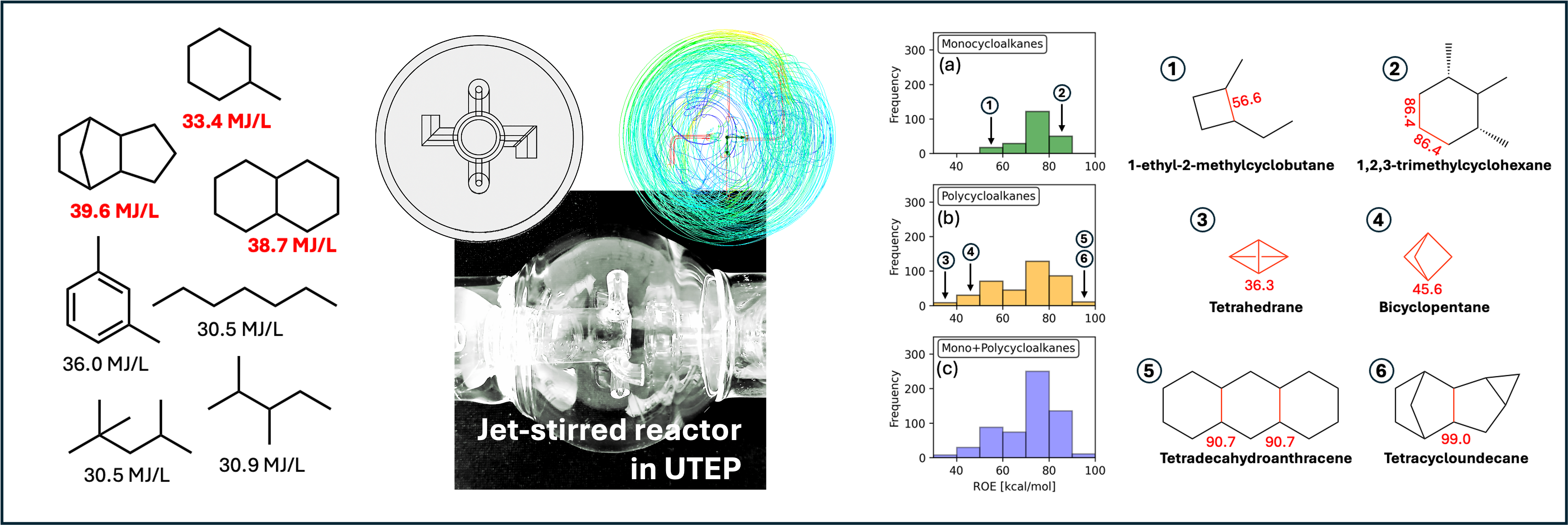Research
1. cycloalkane combustion
Sponsored project: UT Rising Stars, 09/2023 - 08/2026
Sponsored project: UTEP COURI, 05/2024 - 08/2024
Sponsored project: TACC, 02/2025 - 02/2026
Polycycloalkanes have interested aerospace engineers due to their high energy density and low oxidation stability, which usually take up ~30% of conventional aviation fuels. Still, the ring opening energy (ROE) and its relationship with their molecular structure have been understudied, hindering the rational design of the polycycloalkanes for improving propulsion efficiency. The present study provides a systematic analysis of the ROE of mono and poly cycloalkane by leveraging jet-stirred reactor experiments and quantum mechanics calculation.

2. carboxyl-containing RAdical dissociation
Collaborative work with Sandia National Laboratory and Argonne National Laboratory
Prompt dissociations are now a universal feature of free radical dissociations. HCO is a prototypical example whose prompt dissociation was shown to impact flame simulations noticeably. Our recent studies indicate that prompt dissociations of other such free radicals with a carbonyl moiety could also impact practical combustion simulations. In this work, we first aim to understand the branching in the thermal dissociation of carboxy-containing radicals, including CH3CO, CH3OCO, CH2OCHO, and HOCO, as a direct product of hydrogen abstractions from formic acid or secondary reactions in flames of larger acids and esters.

3. NOx emission from the internal combustion engine
Collaborative work with Pusan National University, Korea
Sponsored project: US DOT, 03/2025 - 08/2026
The Paseo del Norte region is recognized for its high ozone (O3) concentrations, which are largely attributed to photochemical reactions between nitrogen oxides (NOx) and volatile organic compounds from transportation sources. This issue is particularly acute in the border city, where heavy traffic flows between the sister cities of El Paso, USA, and Ciudad Juárez, Mexico, significantly impact air quality. Additionally, the Paseo del Norte region is characterized by its hilly terrain, which can cause the transient operation of automobile engines with excessive NOx formation. The proposed project aims to quantify the contribution of transportation NOx from automobile transient operations in hilly terrains through collaborative research between mechanical and civil engineers.

1. flammability of bio-based/bio-degradable polymers
Sponsored project: UTEP ORSP, 01/2024 - 08/2024
As the global production of synthetic polymer has reached hundreds of million tons per year, it raises significant concerns about accumulating waste and greenhouse gas emissions from the polymer. Numerous academic and industry efforts have made remarkable advances in synthesizing biodegradable and bio-based polymers with low environmental impact. However, despite their direct relevance in public safety, there is still a limited understanding of the fire safety of these novel synthetic polymers. The high flammability of synthetic polymer can raise another environmental concern because it leads to a high concentration of flame retardant in the material, which readily dissolves in water resources and has neurodevelopmental toxicity. In this regard, the research aims to provide a fundamental understanding of the fire safety of biodegradable and bio-based polymers.

2. Polymer-to-ceramic conversion of polycarbosilanes
Collaborative work within the department: Dr. Lin and Dr. Castellanos
Silicon carbide (SiC) is a ceramic material that has gained attention in aerospace engineering as a structural material due to its high strength and hardness at elevated temperatures. SMP-10 is a preceramic polymer that transforms into SiC upon pyrolysis, offering significant flexibility in fabricating thermal-resistant materials with complex geometries. Despite its wide range of applications, there is limited understanding of the mechanistic details of the polymer-to-ceramic conversion process of SMP-10. The present study aims to provide a theoretical simulation of SMP-10 pyrolysis based on molecular dynamics (MD) simulation and density functional theory (DFT).

3. AI-based Green Propellant Design
Collaborative work within the department: Dr. Shafirovich and Dr. Renteria
Composite propellants can contaminate groundwater and the atmosphere during production and combustion, influencing biological systems. Although significant progress has been made in replacing conventional oxidizers and metallic powders with green alternatives, comparatively less focus has been placed on developing alternative polymeric binders with minimal environmental impact. Designing novel polymeric binders requires a solid understanding of quantitative structure-property relationships (QSPR) pertaining to their pyrolysis and mechanical characteristics, as well as the toxicity of processing the polymers. The present study leverages the in-house artificial intelligence (AI) model, HEAT-UP, to build the QSPR for polymers and systematically identify alternative polymeric binders that satisfy multiple property criteria.

1. Microplastic sorption kinetics
Collaborative work within the college: Dr. Madeira (CivilE)
Microplastics (MPs) can sorb hydrophobic contaminants, such as pesticides, in water. Herein, we aims to assess the interactions of contaminants and its degradation products with polyethylene (PE) MPs in ultrapure and river water. Dr. Madeira from Civil Engineering conducts kinetics experiments to observe the sorption capacity of MP, while the SPaRK teams provides the theoretical interpretations using density functional theory (DFT) calculation. Our recent paper revealed that the low binding energy between dissolved organic matter (humic acids, HAs) and the contaminat (fipronil) inhibits their adsorption onto MP surfaces coated with HAs, decreasing the adsorption capacity of PE MPs. Our results show that PE MPs may not play a very significant role in the removal and transport of fipronil in waters with high dissolved organic matter concentrations, affecting the bioavailability of these compounds to aquatic organisms.

2. AI-based diagnosis of Musculoskeletal disorder
Collaborative work within the university: Dr. Jang (Kinesiology), Dr. Kim (CivilE), Dr. Renteria (AeroMechE)
Sponsored project: TACC, 02/2025 - 02/2026
Sponsored project: UTEP Dodson, 02/2025 - 05/2026
Sponsored project: UTEP Pilot Grant, 04/2025 - 08/2026
TBA




